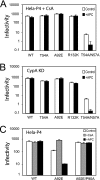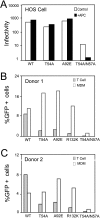Cyclophilin A-dependent restriction of human immunodeficiency virus type 1 capsid mutants for infection of nondividing cells
- PMID: 18829762
- PMCID: PMC2593355
- DOI: 10.1128/JVI.01518-08
Cyclophilin A-dependent restriction of human immunodeficiency virus type 1 capsid mutants for infection of nondividing cells
Abstract
Among retroviruses, lentiviruses are unusual in their ability to efficiently infect both dividing and nondividing cells, such as activated T cells and macrophages, respectively. Recent studies implicate the viral capsid protein (CA) as a key determinant of cell-cycle-independent infection by human immunodeficiency virus type 1 (HIV-1). We investigated the effects of the host cell protein cyclophilin A (CypA), which binds to HIV-1 CA, on HIV-1 infection of nondividing cells. The HIV-1 CA mutants A92E, T54A, and R132K were impaired for infection of aphidicolin-arrested HeLa cells, but not HOS cells. The mutants synthesized normal quantities of two-long-terminal-repeat circles in arrested HeLa cells, indicating that the mutant preintegration complexes can enter the nuclei of both dividing and nondividing cells. The impaired infectivity of the CA mutants on both dividing and nondividing HeLa cells was relieved by either pharmacological or genetic disruption of the CypA-CA interaction or by RNA interference-mediated depletion of CypA expression in target cells. A second-site suppressor of the CypA-restricted phenotype also restored the ability of CypA-restricted HIV-1 mutants to infect growth-arrested HeLa cells. These results indicate that CypA-restricted mutants are specifically impaired at a step between nuclear import and integration in nondividing HeLa cells. This study reveals a novel target cell-specific restriction of HIV-1 CA mutants in nondividing cells that is dependent on CypA-CA interactions.
Figures






Similar articles
-
SUN1 Regulates HIV-1 Nuclear Import in a Manner Dependent on the Interaction between the Viral Capsid and Cellular Cyclophilin A.J Virol. 2018 Jun 13;92(13):e00229-18. doi: 10.1128/JVI.00229-18. Print 2018 Jul 1. J Virol. 2018. PMID: 29643244 Free PMC article.
-
A mutation in alpha helix 3 of CA renders human immunodeficiency virus type 1 cyclosporin A resistant and dependent: rescue by a second-site substitution in a distal region of CA.J Virol. 2007 Apr;81(8):3749-56. doi: 10.1128/JVI.02634-06. Epub 2007 Jan 31. J Virol. 2007. PMID: 17267487 Free PMC article.
-
CA Mutation N57A Has Distinct Strain-Specific HIV-1 Capsid Uncoating and Infectivity Phenotypes.J Virol. 2019 Apr 17;93(9):e00214-19. doi: 10.1128/JVI.00214-19. Print 2019 May 1. J Virol. 2019. PMID: 30814280 Free PMC article.
-
Cyclophilin A Regulates Tripartite Motif 5 Alpha Restriction of HIV-1.Int J Mol Sci. 2025 Jan 9;26(2):495. doi: 10.3390/ijms26020495. Int J Mol Sci. 2025. PMID: 39859212 Free PMC article. Review.
-
Emerging role of cyclophilin A in HIV-1 infection: from producer cell to the target cell nucleus.J Virol. 2023 Nov 30;97(11):e0073223. doi: 10.1128/jvi.00732-23. Epub 2023 Oct 16. J Virol. 2023. PMID: 37843371 Free PMC article. Review.
Cited by
-
Second-site suppressors of HIV-1 capsid mutations: restoration of intracellular activities without correction of intrinsic capsid stability defects.Retrovirology. 2012 Apr 19;9:30. doi: 10.1186/1742-4690-9-30. Retrovirology. 2012. PMID: 22515365 Free PMC article.
-
HIV-1 mutants that escape the cytotoxic T-lymphocytes are defective in viral DNA integration.PNAS Nexus. 2022 May 20;1(2):pgac064. doi: 10.1093/pnasnexus/pgac064. eCollection 2022 May. PNAS Nexus. 2022. PMID: 35719891 Free PMC article.
-
Primate TRIM34 is a broadly-acting, TRIM5-dependent lentiviral restriction factor.Retrovirology. 2023 Aug 22;20(1):15. doi: 10.1186/s12977-023-00629-4. Retrovirology. 2023. PMID: 37608289 Free PMC article.
-
Novel mutant human immunodeficiency virus type 1 strains with high degree of resistance to cynomolgus macaque TRIMCyp generated by random mutagenesis.J Gen Virol. 2016 Apr;97(4):963-976. doi: 10.1099/jgv.0.000408. Epub 2016 Jan 20. J Gen Virol. 2016. PMID: 26795727 Free PMC article.
-
Analysis of the viral elements required in the nuclear import of HIV-1 DNA.J Virol. 2010 Jan;84(2):729-39. doi: 10.1128/JVI.01952-09. Epub 2009 Nov 4. J Virol. 2010. PMID: 19889772 Free PMC article.
References
-
- Bowerman, B., P. O. Brown, J. M. Bishop, and H. E. Varmus. 1989. A nucleoprotein complex mediates the integration of retroviral DNA. Genes Dev. 3469-478. - PubMed
Publication types
MeSH terms
Substances
Grants and funding
LinkOut - more resources
Full Text Sources
Other Literature Sources

